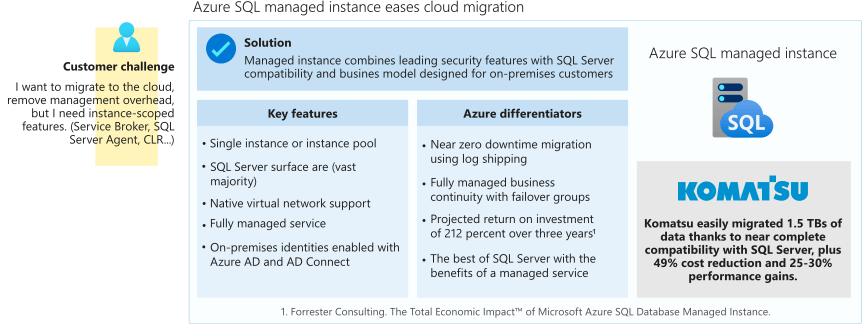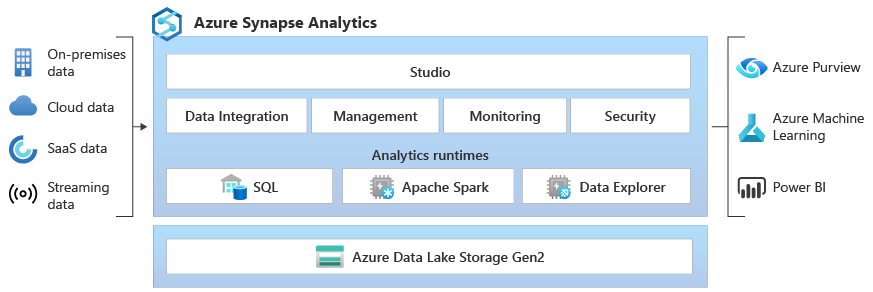Database: Azure provides a variety of relational, NoSQL, and in-memory databases, both fully managed and self-managed, using both proprietary and open-source engines, to meet the needs of today’s app developers and business needs.
Analytics: Big data refers to corporations’ large amounts of structured and unstructured data. Organizations can use this data. An organization can make better judgments by analyzing data for insights. These decisions can boost a company’s performance.
Azure database overview
- Azure Cosmos DB – lightning-fast NoSQL database with flexible APIs
- Azure SQL Database – Relational database with serverless services
- Azure SQL Managed Instance –Relational database with serverless pluse Instance-scoped features
- Azure Database for MySQL – Relational database –open-source databases.
- Azure Database for PostgreSQL – Relational database –open-source databases.
Azure analytics overview
- Azure Synapse Analytics – formerly SQL Data Warehouse
- Azure HDInsight – Fully managed, open-source analytics service
- Azure Databricks – optimized version of Apache Spark from HDInsight Spark
- Azure Data Lake Analytics – simplified big data analytics work available on demand
Azure Cosmos Database
If you need a database service that is accessible from anywhere in the world, look no further than Cosmos Database. If your data is stored in multiple locations throughout the world, you can still easily manage it with this system.
There is only one backend, but it can support many data models. As a result, it may be applied to various types of models, including documents, key-value stores, relations, and graphs. As it does not require any predefined schemas, it might be considered a NoSQL database. The fact that it supports numerous data types, and employs a query language that is comparable to SQL, and ACID (atomicity, consistency, isolation, and durability)
Fast, Always On, single-digit-millisecond data access; support changing data.Its support JSON/JavaScript directly. Used for IoT and telematics
Cosmos DB stores data in atom-record-sequence (ARS)
IoT/Telematics, Retail/Marketing (Windows Store/XBox Live), Gaming, Social Apps,MongoDB, Cassandra, Tables, and Gremlin APIs.
Azure SQL Database
Since Azure SQL Database is a PaaS database engine, it takes care of most database administration tasks such as backups, patches, upgrades, and monitoring with minimal input from the user.
Using this method of deployment, you just need to acquire a database upon which to build your software. The sole deployment choice that allows for both unlimited database storage (hyper scale) and autoscaling for fluctuating workloads is SQL Database (serverless)
LAMP stack applications, Content Management Systems, and Management Software such as phpMyAdmin.

Azure SQL Managed Instance
Both Azure SQL Database and Azure SQL Managed Instance provide access to a number of the same features. On the other hand, Azure SQL Managed Instance makes available a number of customization possibilities that Azure SQL Database might not. It provides you with an instance of SQL Server while removing a significant portion of the burden associated with administering an Azure virtual machine or virtual machine on-premise
Manged Instance offers : SQL Server Agent, Service Broker, common language runtime (CLR), Database Mail, linked servers, distributed transactions (preview), and Machine Learning Services.

Azure Database for MySQL
DBaaS is a service that allows businesses to access databases in the cloud. A DBaaS delivery platform allows you to concentrate on designing database apps rather than managing virtual machines (VMs) and their associated infrastructure. You may use Azure Database for MySQL to run your database apps as a service. Microsoft Azure manages platform configuration and maintenance, so you don’t have to worry about that.
Azure Database for PostgreSQL
The managed database service Azure Database for PostgreSQL offers high availability and massively scalable PostgreSQL in the cloud. The solution is built on top of PostgreSQL and customized Azure services.
Flexible server: Zone-resilient workloads
Single Server: don’t need customization or low latency across regions
Azure Synapse Analytics
Service for unlimited analytics that combines traditional data warehousing with newer forms of big data analysis. Whether you prefer serverless or provided resources, you have the flexibility to conduct data queries on your terms. All the steps required to acquire, cleanse, transform, and deliver data for rapid use in business intelligence and machine learning are consolidated into a single, simple interface.
SQL and Spark technologies for enterprise data warehousing, log and time series analytics, data integration and ELT ( Extract, load, and transform ) / ETL ( the next generation of ETL ) , including Power BI, CosmosDB, and AzureML.
Data to be loaded, modeled, processed, and distributed for analytic insights within Azure.

Azure HDInsight
Azure HDInsight is an enterprise open-source analytics service. It’s a cloud service that makes processing big data easier, faster, and cheaper.
- Apache Hadoop – Big data sets on clusters
- Apache Spark – Store and process your data all within Azure
- Apache Hive – Distributed, fault-tolerant data warehouse enabling large analytics
- Apache Kafka – Real-time data pipelines and apps
HDInsight for big-data scenarios. works on scenarios such as extract, transform, and load (ETL), data warehousing, machine learning, and IoT.
- Batch processing – Processing the data, Reading diverse source files, and Writing the data to scalable storage.
- Data warehousing – Store, prepare and provide the prepared data in a structured format
- IoT – Long-term storage, Real-time apps, and Real-time dashboards
- Data Science – Data ingestion, Feature engineering, Modeling, and Model Evaluation
- Hybrid – Expand on-premises large data to Azure.
Azure Databricks
Azure Databricks uses a version of Apache Spark called Databricks Runtime. It doubles Apache Spark’s performance. Azure Databricks offers fast, easy, collaborative Spark-based analytics. It speeds up big data analytics, AI, data lakes, data science, ML, and collaboration.
- The cluster is where we run code.
- The workspace groups all Databricks clusters, notebooks, and data.
- The notebook contains runnable code, text, and visualizations.
Apache Spark workspaces allow autoscaling and shared project collaboration. Python, Scala, R, Java, SQL, TensorFlow, PyTorch, and scikit-learn are supported.
Azure Data Lake Analytics
The term “data lake” refers to a single, centralized repository that may be used to store all of your data, whether it be structured or unstructured. Keeping your data in its original or raw format, which is typically in the form of files or binary big objects, is recommended (blobs).
When you need to modify your data and extract useful insights, but don’t want to deploy, configure, and tune hardware, you may write queries instead. When you dial in how much processing power you need, the analytics service can handle workloads of any size immediately. It’s more cost-efficient since you only have to pay for your work when it’s actually being done.
Enterprise data lake. It’s designed to store and analyse huge data in any format. It captures any kind and pace of data input in a single spot for simple access and analysis.
Azure Data Lake Storage’s features include:
- Data storage – Native format of any data
- Data access – Hierarchical namespace
- Data costs – Automated Lifecycle Policy Management and Object Level tiering
- Data performance – available throughput; wants to read and write simultaneously.
- Data security – Azure RBAC and ACLs- Portable Operating System Interface for UNIX (POSIX)
- Data redundancy – locally redundant storage (LRS) and geo-redundant storage (GRS)
- Data scalability – It doesn’t limit account sizes, file sizes, or data lake storage.
- Data analysis – Apache Hadoop Distributed File System (HDFS) and data extracted from the Azure Blob Storage (ABFS)
Here are some of the analytic frameworks that operate with Azure’s Data Lake Storage:
- Azure HDInsight
- Azure Machine Learning
- Azure Synapse Analytics
- Microsoft Power BI




